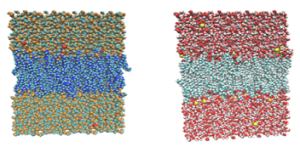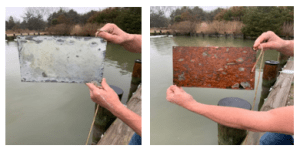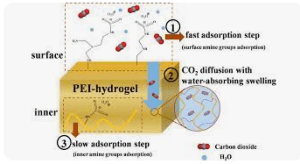
Kio, Michael P.E.
Assistant Research Professor
Chemical and Biomolecular Engineering
2208 Chemical and Nuclear Engineering Building
mkio@umd.edu
301-405-1923
Nanoparticle and Plasma Membrane Modelling
 The goal of this research interest is the drug carrier transport mechanism of nanoparticles through the plasma membrane of healthy and cancerous cells. This research interest delivers a deeper and novel physical understanding of the transport mechanism of functionalized nanoparticles in cancer plasma membranes in comparison with healthy membranes, probing interactions, transport of nanoparticles as drug carriers, and implementing Nanoscale Molecular Dynamics (NAMD) with models built with the CHARMM-GUI membrane builder and the CHARMM36 lipid and Martini force fields. Various presentations have been given to both private and public audiences, with accompanying materials published accordingly.
The goal of this research interest is the drug carrier transport mechanism of nanoparticles through the plasma membrane of healthy and cancerous cells. This research interest delivers a deeper and novel physical understanding of the transport mechanism of functionalized nanoparticles in cancer plasma membranes in comparison with healthy membranes, probing interactions, transport of nanoparticles as drug carriers, and implementing Nanoscale Molecular Dynamics (NAMD) with models built with the CHARMM-GUI membrane builder and the CHARMM36 lipid and Martini force fields. Various presentations have been given to both private and public audiences, with accompanying materials published accordingly.
The specific aim of this study is to develop a comprehensive understanding of how nanoparticles interact and translocate through plasma membranes. This is achieved by extending the parameters of CHARMM force fields to incorporate interactions between nanoparticles and phospholipids. Experimental techniques such as SEM, TEM, AFM, DLS, and FTIR are implemented. The significance of this research is to advance the field of nanomedicine and biomanufacturing by working closely with our collaborators in institutions, national laboratories, industries, and government agencies to translate our findings into practical applications that benefit society.
Antifouling and Fouling Release Coating

The goal of this research interest proposes the research and development of an enhanced hybrid polymer antifouling, fouling-release, anti-icing, de-icing, and anticorrosion coating formulation matrix for sea instruments, fuselages, airplane wings, internal seawater systems, hulls, and keels of ships. This project synthesizes and characterizes a plurality of fumed silica and hydrogel-based polymer antifouling, de-icing, and anti-corrosion coatings. Models are developed in the laboratory to probe these  phenomena by implementing computational and experimental techniques. Using NSF National I-Corp funds, a proof-of-concept prototype fouling-release coating formulation was created, with ongoing research continuing with the help of an NSF/ASEE fellowship. The expectation is the development of a pilot prototype and patent.
phenomena by implementing computational and experimental techniques. Using NSF National I-Corp funds, a proof-of-concept prototype fouling-release coating formulation was created, with ongoing research continuing with the help of an NSF/ASEE fellowship. The expectation is the development of a pilot prototype and patent.
Carbon Capture Implementing Biomaterials and Hydrogels

The concept of this research stemmed from exploring connections between the study of modeling plasma membranes and fouling release coating formulations.
Microalgae have great potential in terms of CO₂ fixation, yet their low diffusion ability and short CO₂ residence time limit their effectiveness. Hydrogels can be used to immobilize microalgae as CO₂ adsorbents, which increase their growth rate. Mutagenesis, genetic engineering, and nanomaterials are promising techniques to improve the biofixation of CO₂ in microalgae; however, these methods still face many challenges. Thus, it is crucial to conduct further investigations implementing molecular dynamics simulation on the tolerance of hydrogels and biomaterials towards higher levels of CO₂ concentration to successfully capture and mitigate CO₂. This research has potential applications in the development of innovative batteries and carbon capture techniques.
Doctoral Dissertation Committee
Examiner
Graduate Students
Mehedi Hasan
Research Topic: Design of Functional Polymer Nanocomposites Via Reactive Molecular Dynamics
PhD Student
Undergraduate Students
Abhi Senthikumar
Major: Chemical Engineering
Class of 2026
Evan Roeteringa
Major: Bioengineering
Class of 2025
Alena Zheng
Major: Bioengineering
Class of 2025
Jordan Lewis
Major: Biology
Class of 2025
Srivishnu Pyda
Major: Computer Science
Class of 2025
High School Students
Aneesh Puranam
Senior: River Hill School, Clarksville, Maryland
Chianugo Okeke
Senior: Eleanor Roosevelt High School, Maryland
Zunainah Afifah
Senior: Eleanor Roosevelt High School, Maryland
Andrew Evans
Senior: Eleanor Roosevelt High School, Maryland
School Club Advising
Terrapin Rocket Team
Winner of the 2024 Spaceport America Cup, the largest intercollegiate rocket competition in the world
Our Collaborators, Partners, and Sponsors












